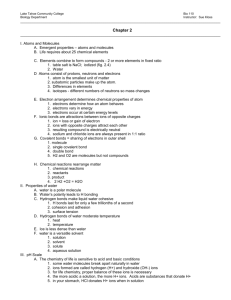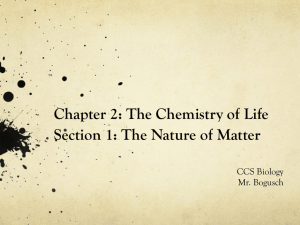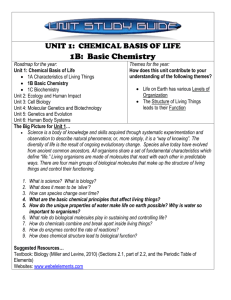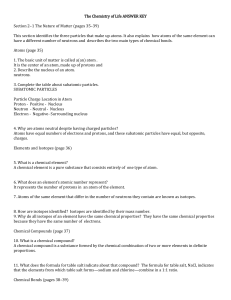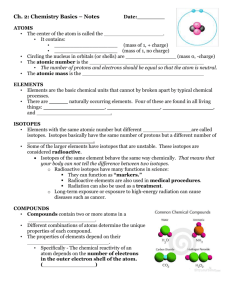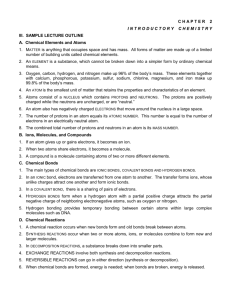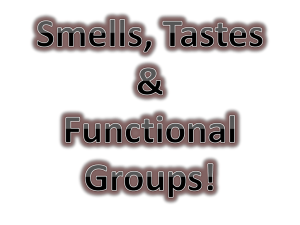Chapter 2 Basic Chemistry
advertisement
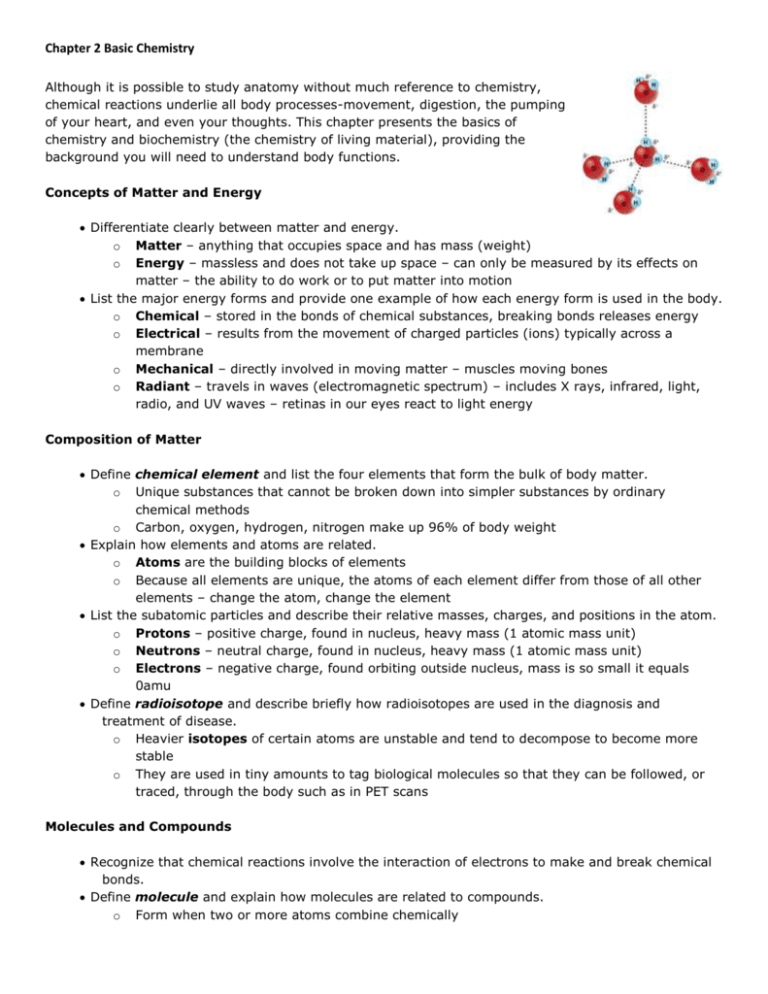
Chapter 2 Basic Chemistry Although it is possible to study anatomy without much reference to chemistry, chemical reactions underlie all body processes-movement, digestion, the pumping of your heart, and even your thoughts. This chapter presents the basics of chemistry and biochemistry (the chemistry of living material), providing the background you will need to understand body functions. Concepts of Matter and Energy Differentiate clearly between matter and energy. o Matter – anything that occupies space and has mass (weight) o Energy – massless and does not take up space – can only be measured by its effects on matter – the ability to do work or to put matter into motion List the major energy forms and provide one example of how each energy form is used in the body. o Chemical – stored in the bonds of chemical substances, breaking bonds releases energy o Electrical – results from the movement of charged particles (ions) typically across a membrane o Mechanical – directly involved in moving matter – muscles moving bones o Radiant – travels in waves (electromagnetic spectrum) – includes X rays, infrared, light, radio, and UV waves – retinas in our eyes react to light energy Composition of Matter Define chemical element and list the four elements that form the bulk of body matter. o Unique substances that cannot be broken down into simpler substances by ordinary chemical methods o Carbon, oxygen, hydrogen, nitrogen make up 96% of body weight Explain how elements and atoms are related. o Atoms are the building blocks of elements o Because all elements are unique, the atoms of each element differ from those of all other elements – change the atom, change the element List the subatomic particles and describe their relative masses, charges, and positions in the atom. o Protons – positive charge, found in nucleus, heavy mass (1 atomic mass unit) o Neutrons – neutral charge, found in nucleus, heavy mass (1 atomic mass unit) o Electrons – negative charge, found orbiting outside nucleus, mass is so small it equals 0amu Define radioisotope and describe briefly how radioisotopes are used in the diagnosis and treatment of disease. o Heavier isotopes of certain atoms are unstable and tend to decompose to become more stable o They are used in tiny amounts to tag biological molecules so that they can be followed, or traced, through the body such as in PET scans Molecules and Compounds Recognize that chemical reactions involve the interaction of electrons to make and break chemical bonds. Define molecule and explain how molecules are related to compounds. o Form when two or more atoms combine chemically When two+ atoms of the same element bond together, a molecule of the element forms When two+ atoms of different elements bond together to form a molecule, it is called a compound Chemical Bonds and Chemical Reactions Differentiate between ionic, polar covalent, and nonpolar covalent bonds, and describe the importance of hydrogen bonds. o Ionic – form when electrons are completely transferred from one atom to another forming ions – typical of salts o Covalent – form when electrons are shared in such a way that each atom is able to fill its valence shell at least part of the time Polar – covalent bond where the electrons are not shared equally and the electrons spend more time with the larger atom giving it a negative charge and the opposite atom a positive charge – water Nonpolar – covalent bond where the electrons are shared equally giving the molecule no charge – carbon dioxide o Hydrogen bonds – extremely weak bonds between hydrogen and another positively charged atom such as oxygen or nitrogen that give water its surface tension properties – also important intramolecular bonds that help bind different parts of molecules together to form a specific 3-D structure such as in proteins Contrast synthesis, decomposition, and exchange reactions. o Synthesis – occur when two+ atoms or molecules combine to form a larger more complex molecule ( A + B AB) o Decomposition – occurs when a molecule is broken down into smaller molecules, atoms, or ions (AB A + B) o Exchange – both synthesis and decomposition reactions with bonds made and broken – a switch is made between molecule parts and different molecules are made (AB + C AC + B) or (AB + CD AD + CB) Biochemistry: The Chemical Composition of Living Matter Distinguish between organic and inorganic compounds. o Organic – contain carbon Carbohydrates – sugars, starches – contain C, H, O in a 1:2:1 ratio Mono, di, polysaccharides Simple sugars strung together by dehydration synthesis reactions – water molecule is lost with bond formation Lipids – phospholipids, steroids (including cholesterol), triglycerides – contain C, H, O with C and H outnumbering O – most insoluble in water Proteins – contain C, H, O, N and sometimes S – made up of amino acids strung together with peptide bonds Fibrous (structural) proteins – bind structures together Globular (functional) proteins – do things – antibodies, enzymes (-ase ending), hormones Both can be denatured by heat, pH changes – change structure, change function Nucleic acids –DNA, RNA – nucleotides strung together DNA – genetic material – semi-conservative replication RNA – three types – mRNA, tRNA, rRNA – transcription and translation (protein synthesis) ATP – adenosine triphosphate – chemical energy molecule – modified nucleotide – energy is released with bond between 2nd and 3rd phosphate is broken o Inorganic – do not typically contain carbon and are simpler, smaller molecules such as water, salts, many acids and bases Differentiate clearly between a salt, an acid, and a base. o Salt – ionic compounds that when dissolved in body fluids separate into their ions – electrolytes that conduct electrical currents in solution o Acid – taste sour and can dissolve many metals or burn holes in materials including skin – a substance that can release hydrogen ions (H+) in detectable amounts – proton donors (hydrogen ions are a hydrogen nucleus without any electrons – essentially just the proton in the nucleus) o Base – taste bitter, feel slippery – proton acceptors – ionize and dissociate in water to release hydroxyl ion (OH-) List several salts (or their ions) vitally important to body functioning. o See page 24 table 2.1

